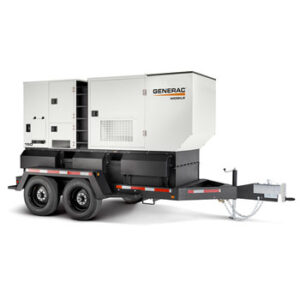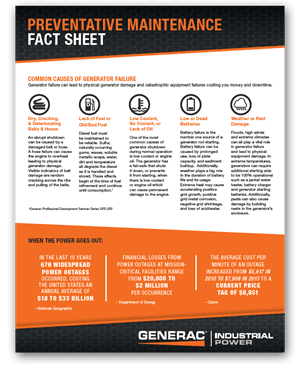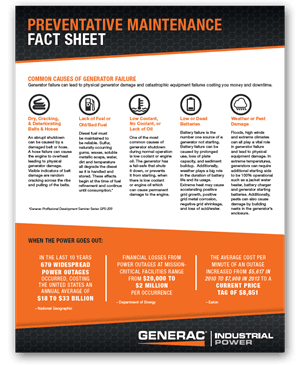October 2020 Articles:
- Paralleling Mobile Generators
- Preventative Maintenance Fact Sheet
- Upcoming Webinar: Writing Performance-Based Specs

In the past, one generator would be tasked with powering one operation. The unit would have to be enough power to operate all of the tools and equipment on the jobsite. However operating several smaller generators in parallel might be a more efficient and versatile solution. This paper will provide an overview of paralleling prime power solutions and the benefits it presents.
INTRODUCTION
Paralleling is when two or more generators are electrically coupled to form a larger-capacity power source. Paralleling generators is not a new concept, but it has been simplified with microprocessor controls. Many capabilities are now built into the generator, making it more user-friendly and plug-and-play. Paralleling offers more flexibility and redundancy and can be used to allow two or more smaller generators to perform like a single larger one.
The generators need to be synchronized. To do that, the control systems of the generators need to talk to each other. The goal is to get both generators to be producing the same voltage and frequency as well as the same phase angle so the generators peak at the same time. If the generators fall out of sync, you are more likely going to damage the equipment.
You can also set the percentage of contribution from each unit. You have controls that are capable of being set so each gen-set that is paralleled will have a contribution toward the total power of the application. Load management and power sharing allow you to assign how much power each generator produces.
You need to manage the same electrical parameters whether it is a newer or older machine. The difference is the newer machines will be more user friendly. The controls are going to be easier to use and will do things more automatically with fewer manual settings. These controls have simplified what used to be very complex. Paralleling has always been a great tool that offers a lot more flexibility and reliability if one machine goes down.
HOW TO PARALLEL A MOBILE GENERATOR
When connecting one generator or multiple generators to a common bus, it is still considered paralleling. There are many different scenarios where paralleling is used, but for this whitepaper, we will keep it simple and to the point with two similar-make, current model, kW generators to a common bus.
Whether you plan on renting or purchasing mobile generators to parallel a site, you must first clearly define the requirements of the particular site. You will need to identify your power requirements in kilowatts and volts, along with fuel source, footprint, distance from load, etc. This is also a good time to map out how you would like them to operate. For example, you need to determine the need for redundancy, run hour equalization, as well as engine optimization and load demand when using different size generators. Generac recommends that all electrical work be completed by a licensed professional.
Once the mobile units arrive on site, they need to be levelled and secured properly. They need to be inspected for any damages that might have occurred during transport. Prior to starting the engine, we recommend following the prestart checklist outlined in the operator’s manual. At this point, you will need to run the cables from the generator to the common bus or an Automatic Transfer Switch (ATS). The cables must be properly rated to handle the distance and current of the generators full rated output. Since we are talking about mobile generators, you will need to make sure the cables are safe from causing a hazard. Some applications will require heavy-duty cable protectors, to prevent trip points or being run over by a piece of equipment. The electrician will also need to confirm the proper phase rotation and that the unit is properly grounded according to the local code.
Next, in order for the two generators to synchronize together they must be able to communicate to one another. Each generator should come with a CAN communication cable that needs to be terminated at each generator in the series. Regardless of the number of generator sets in the paralleling system, a 120-ohm resistor needs to be installed at the beginning and the end of the series. In other words, if you have five generators in the system, you need to install the resistor on generator number one and number five.
Typically, in a mobile application the units are started and paralleled manually. If you want the generators to start automatically, you will need to wire two wires from the transfer switch to the auto start contacts on the generator. The ATS is constantly monitoring utility and the generator’s voltage. Once the utility voltage is reduced to a preset value or completely drops out, the ATS closes the two-wire start contact, which starts the generator. Once the generator is producing the proper voltage, the ATS switches the source from utility to generator. This also works in reverse, once the ATS senses utility; it switches the source back to utility and opens, or disconnects, the two-wire contact and shuts down the generator.
All units are factory tested and have preset control loop parameters. Further tuning is not typically required, but can be performed to improve synchronization performance based on the nuances of different sites, such as elevation and fuel supply. The term ‘tuning’ refers to the optimization of Proportional, Integral, Derivative (PID) control loop parameters within the controller to improve the response to a synchronization request and performance. Based on different control manufacturers, there are procedures for the initial setup, which is required by a factory authorized generator technician. Though the process might vary from different control manufacturers, the basic concept is the same. After all controllers are properly connected to the CAN bus, confirmation that each controller has full control of engine speed and voltage is required. To do this, using proprietary software, we manually alter the speed governor bias and the AVR excitation bias to each generator. This is recommended to perform on each unit prior to every parallel setup. Connecting controllers that do not have proper control can cause the units to not parallel together or cause the system to become unstable and shutdown.
Once the initial set up is complete paralleling two units to the common bus is fairly simple. First, we do not recommend manually closing the breaker from the breaker. Severe damage can occur if the breakers close when the two units are not in sync. Once both generators are running and are at the rated speed and voltage you can go ahead and press the “close breaker” button on the controller. The breaker should close instantaneously and provide voltage to the common bus. Next, you can press the “close breaker” button on the second generator. The breaker will not close immediately because the controller first needs to start the synchronization process to the live bus. In order for units to parallel, the voltage, frequency and phase angle of the connecting generator must match the bus. Once these parameters match, the breaker will close and lock together with the first generator electrically. At this point the two generators will begin to
share load.
In order to take the generators offline, you press the “open breaker” button on the controller one generator at a time. Once the load is removed from the generator it is recommended that you let the engines cool down for a few minutes prior to turning the generators off. Depending on the controller, cool down times can be integrated into shutdown sequence, in other words, once you press the off button, the engine will go into a cool down mode for a preset amount of time.
BENEFITS OF GENERATOR PARALLELING
Although there are many benefits to paralleling generators, the main benefit is that it can be used to link small generators together to perform like a larger one. Doing this provides:
- Increased Utilization: Several small generators working together in parallel can be rented out individually for smaller applications and sent out together for larger applications.
- Redundancy: If one generator fails, the second generator will pick up its load without any disruption in power. Redundant generators can also be set up to balance engine hours and to take turns shutting down for maintenance.
- Motor starting: Motor starting requires a great deal of current for startup and less power once the motor is running. The units can run in parallel to perform the motor starting and then one or more units can shut down, allowing the other to run at peak load. This avoids oversizing a single large generator and the related problems it brings, such as wet stacking that comes from operating long-term and less than full load.
Paralleling for generator users can come down to load management. If load projections are high, the initial investment in generators may be larger than necessary. If projections are low, reliability could be compromised or expensive generator upgrades may be required. By operating in parallel, it is easier to allow for variations in load without exceeding budget.
CONCLUSION
Instead of operating one large mobile generator, operating several smaller generators in parallel might be a more efficient and versatile solution. Paralleling multiple units provides increased reliability, flexibility in load management and maintenance capabilities with little to no disruption. Several small generators can be rented out individually for smaller applications and later paralleled for larger applications. This is useful in applications such as motor starting, which requires a great deal of current for startup and less power once the motor is running. By operating in parallel, it is easier to allow for variations in load without exceeding budget. Regardless of what type of paralleling setup is required, Generac Mobile Products recommends engaging a skilled technician to configure the generators.
 Preventative Maintenance Fact Sheet
Preventative Maintenance Fact Sheet
The primary cause of generator failure is lack of maintenance. Neglecting generator maintenance can lead to physical generator damage and catastrophic equipment failures costing you money and downtime.
Know the 5 main Causes of Generator Failure
Download the Preventative Maintenance Fact Sheet
Whatever your application, ESSE can help you create and put a maintenance plan into place giving you the peace of mind you deserve. We are here to support your maintenance needs 24/7 ensuring that your backup power assets are protected. We’re here to help. Contact us for more information.
Upcoming Webinar: Writing Performance-Based Specs
 There are many elements that need to be considered when writing specifications for engine generator sets. Join us for a 30 minute webinar where you’ll learn in depth about these elements necessary to put together a comprehensive specification. We will define the scope of the applications along with relevant NEC and NFPA considerations.
There are many elements that need to be considered when writing specifications for engine generator sets. Join us for a 30 minute webinar where you’ll learn in depth about these elements necessary to put together a comprehensive specification. We will define the scope of the applications along with relevant NEC and NFPA considerations.
- Key genset performance measures – what’s relevant and what’s not
- Options and accessories necessary to meet code and application fit
- Application unique elements
- Startup and commissioning requirements
November 12th, 12:30 PM ET



